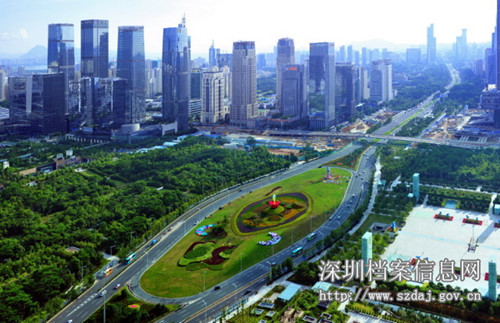Shenzhen
Shenzhen is located on the southern tip of the Chinese mainland and on the eastern bank of the Pearl River. It neighbors Hong Kong. Occupying 1,991.64 square kilometers, the city has a subtropical marine climate with plenty of rain and sunshine and is rich in tropical fruit. By the end of 2021, there were 17.68 million permanent residents.
The country's first special economic zone - the brainchild of late Chinese leader Deng Xiaoping - was established here in 1980. Shenzhen has been a touchstone for China's reform and opening-up policy since then.
In merely 40 years, Shenzhen, once a tiny border town of just over 30,000 people, has grown into a modern metropolis. It established many firsts in the history of world industrialization, urbanization and modernization.
 |
| The central business district of Shenzhen |
The city is the high-tech and manufacturing hub of southern China, home to the world's third-busiest container port and the fourth-busiest airport on the Chinese mainland. It is one of the country's most popular tourist destinations. It was also elected one of the top 10 Chinese cities popular with expats in 2015. The high-tech, financial services, modern logistics and cultural industries are mainstays of the city. Emerging industries of strategic importance and modern service industries are quickly becoming new engines for the city's economic growth. Shenzhen has set up new standards of "Shenzhen Quality" and "China Quality" on sustainable development and globalization.
As a State-level innovative city, Shenzhen has chosen independent innovation as the dominant strategy for its future development. The city's social investment in research and development in 2015 accounted for 4.05 percent of its GDP, which was twice the national average and outnumbered that of some developed countries. The number of Shenzhen's PCT (Patent Cooperation Treaty) applications has topped Chinese cities for several years. The 4G technology, genetic sequencing analysis, metamaterial technology, new energy automobile and 3D display technology are among the leading technologies in the world. Over the years, the number of makers in Shenzhen has been growing drastically. Many of the institutions, including Chaihuo Maker Space, Makeblock and Seeed Studio, have already gained much fame and influence both domestically and overseas. A Maker Week is held every June in Shenzhen, which provides makers from all over the world an international platform to create and innovate.
Shenzhen is the window of China's reform and opening up and one of the Chinese cities that enjoy the highest degree of opening up. Its export has topped the nation's large and medium-sized cities for 23 consecutive years.
 |
| Night view of the central business district of Shenzhen |
Shenzhen strives to play a pivotal role in the implementation of the Belt and Road Initiative to build itself into a gateway along the 21st-Century Maritime Silk Road by making full use of its geographic location and advantages in business and human resources, putting emphasis on the development of the Guangdong-Hong Kong-Macao Greater Bay Area, and focusing on transportation connectivity, economic and trade cooperation and cultural exchanges.
Shenzhen is an ecological garden city, with half of its total area under a form of environmental protection that bans construction. Shenzhen is China's first city to win the Nations in Bloom Award, and named on the United Nations Environment Program's Global 500 Laureate Roll of Honor.
A picturesque coastal city, Shenzhen is a popular tourist destination in South China and has been listed by the Chinese Government as an Excellent Tourist City.
Shenzhen, a city of compassion with a deep-rooted volunteer culture, has 10,100 social organizations and more than 1.1 million registered volunteers. Selected as China's "Most Charitable City" for several consecutive years, it promotes Project Care each year to help disadvantaged groups, and has been called a "city with no winter."



 Print
Print Mail
Mail

